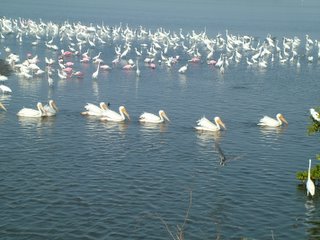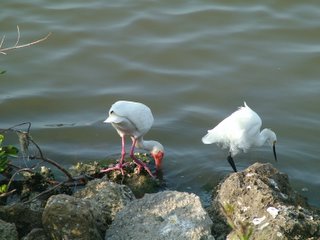10. Coastal S.W. Florida
 When visiting coastal S.W. Florida, say from Tampa/St. Pete down to Sanibel and Captiva, one of the first things that impress you are the trees. Large, showy trees, such as this one in St. Petersburg.
When visiting coastal S.W. Florida, say from Tampa/St. Pete down to Sanibel and Captiva, one of the first things that impress you are the trees. Large, showy trees, such as this one in St. Petersburg.
Often, when near water, the foliage literally drips into the water, as if the tree were taking a drink.

Others like this one, perhaps a live oak, is dripping with spanish moss, a common symbiont of southern trees. But, I tell you, the trees are impressive.
 When I am visiting friends on Sanibel Island, I will often bike through the Ding Darling preserve to observe the wildlife. Occasionally I'm lucky and see interesting sights, such as this small mangrove crab. You have to look carefully to see them!
When I am visiting friends on Sanibel Island, I will often bike through the Ding Darling preserve to observe the wildlife. Occasionally I'm lucky and see interesting sights, such as this small mangrove crab. You have to look carefully to see them!
This curious fellow came out of the mangrove swamp to see if we had some food to give him/her. Of course, we did not feed the raccoon as it is against the regulations in the preserve.

Everybody comes to Ding Darling to see the alligator. More often than not, what you see are two eyes out of the water; the rest of the animal is beneath the water.

They look like they are sleeping, but you can be assured that they are keeping there eyes on you and trying to guess if you could be their next meal. Some of these are 6-8 feet long, and they can move fast if they want to.

The real treasure of Ding Darling is its bird population. At low tide, hundreds of birds check out the waterways for food. Then you can see snowy egrets, great egrets, roseate spoonbills, anhinga, white pelicans and white ibis, along with many others. Quite a sight.

Gere a great edret checks out the shoreline for anything edible. These birds can be 2 1/2 to 3 feet tall.

The roseate spoonbill's coloration shows that they are in mating colors. The redder the color the more mature and ready for mating.
 The bird at the top of this picture is "fishing" for food. By dragging its feet in the water, the bird drives the fish in certain direction where they can be harvested. The lower bird is great egret.
The bird at the top of this picture is "fishing" for food. By dragging its feet in the water, the bird drives the fish in certain direction where they can be harvested. The lower bird is great egret.
In this picture, the white pelicans have formed a nice line, all off to a new location where they will again start scooping out bait fish.

Here a couple of snowy egrets check out the shallows for something to eat.

A white ibis (orange beak) is in the midst of catching lunch, while the snowy egret next to it is looking for a meal.

A great blue heron stalks the shallows on this waterway for food. They will also stalk the land for snakes. lizards and such.

0 Comments:
Post a Comment
<< Home